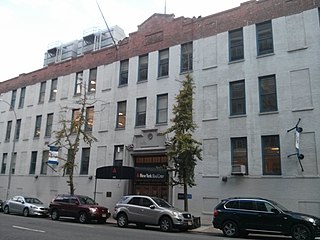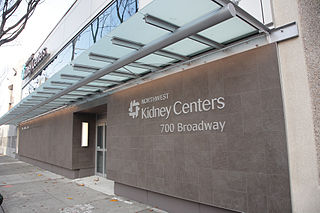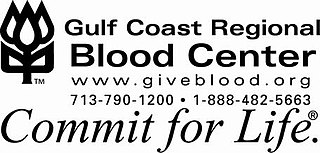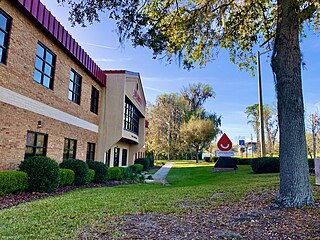
AABB is an international, not-for-profit organization representing individuals and institutions involved in the field of transfusion medicine and biotherapies.

Roswell Park Comprehensive Cancer Center is a cancer research and treatment center located in Buffalo, New York. Founded by surgeon Roswell Park in 1898, the center was the first in the United States to specifically focus on cancer research. The center is usually called Roswell Park in short. The center, which conducts clinical research on cancer as well as the development new drugs, provides advanced treatment for all forms of adult and pediatric cancer, and serves as a member of the National Comprehensive Cancer Network. Roswell Park Comprehensive Cancer Center is as of 2019, the only upstate New York facility to hold the National Cancer Institute designation of "comprehensive cancer center".
UC San Diego Health is the academic health system of the University of California, San Diego in San Diego, California. It is the only academic health system serving San Diego and has one of three adult Level I trauma centers in the region. In operation since 1966, it comprises three major hospitals: UC San Diego Medical Center in Hillcrest, Jacobs Medical Center in La Jolla, and UC San Diego Health East Campus Medical Center in East County. The La Jolla campus also includes the Moores Cancer Center, Shiley Eye Institute, Sulpizio Cardiovascular Center, and Koman Family Outpatient Pavilion, and the health system also includes several outpatient sites located throughout San Diego County. UC San Diego Health works closely with the university's School of Medicine and Skaggs School of Pharmacy to provide training to medical and pharmacy students and advanced clinical care to patients.

M Health Fairview University of Minnesota Medical Center (UMMC) previously known as University of Minnesota Medical Center, is a 1700-bed non-profit, tertiary, research and academic medical center located in Minneapolis, Minnesota, servicing the entire region. UMMC is the region's only university-level academic medical center. The hospital is operated by the M Health Fairview Health System and the largest hospital in the system. UMMC is affiliated with the University of Minnesota Medical School. UMMC is also an ACS designated level II trauma center and has a rooftop helipad to handle medevac patients. Attached to the medical center is the Masonic Children's Hospital that treats infants, children, adolescents, and young adults up to the age of 21.
Australian Red Cross Lifeblood, simply known as Lifeblood, is a branch of the Australian Red Cross responsible for the collection and distribution of blood and biological products in Australia. Lifeblood employs around 3,700 employees across scientific, clinical and support services, processing over one and a half a million blood donations each year. Lifeblood is primarily funded by the Australian Government and state and territory governments.

Universal Health Services, Inc. (UHS) is an American Fortune 500 company that provides hospital and healthcare services, based in King of Prussia, Pennsylvania. In 2023, UHS reported total revenues of $14.3b.
The National Marrow Donor Program (NMDP) is a nonprofit organization founded in 1986 and based in Minneapolis, Minnesota, that operates the Be The Match Registry of volunteer hematopoietic cell donors and umbilical cord blood units in the United States.

The New York Blood Center (NYBC) is a community, nonprofit blood bank based in New York City. Established in 1964 by Dr. Aaron Kellner, NYBC supplies blood to approximately 200 hospitals in the Northeast United States. NYBC and its operating divisions also provide transfusion-related medical services to over 500 hospitals nationally.

Dignity Health is a California-based not-for-profit public-benefit corporation that operated hospitals and ancillary care facilities in three states. Dignity Health was the fifth-largest hospital system in the nation and the largest not-for-profit hospital provider in California.

Northwest Kidney Centers is a regional, not-for-profit community-based provider of kidney dialysis, public health education, and research into the causes and treatments of chronic kidney disease. Established in Seattle in 1962, it was the world's first out-of-hospital dialysis provider. It offers dialysis throughout the greater Seattle area in 20 free-standing clinics, eight hospitals and its home dialysis program. It opened its first clinic in Everett in 2020, the organization's first in Snohomish county.
The Healthcare Systems Bureau is part of the Health Resources and Services Administration (HRSA), of the United States Department of Health and Human Services.

Gulf Coast Regional Blood Center is the only blood provider in Houston and its surrounding communities 24 hours a day, 7 days a week. It is one of the largest independent community blood centers in the United States serving 26 counties from the Texas Gulf Coast to Brazos Valley to East Texas. The nonprofit supplies blood to more than 170 hospitals and health care institutions including the Texas Medical Center, the largest medical center in the world. Gulf Coast Regional Blood Center is a proud member of the American Association of Blood Banks (AABB), Blood Centers of America, South Central Association of Blood Banks, Texas Medical Center and America's Blood Centers. Operations started on January 1, 1975, with 64 employees. Today, Gulf Coast Regional Blood Center has over 650 staff members. The overall supervision of Gulf Coast Regional Blood Center's activities is the responsibility of a chief executive officer appointed by the board of trustees. Medical supervision and direction for Gulf Coast Regional Blood Center are provided by a Chief Medical Officer also appointed by the board of trustees.

A human milk bank, breast milk bank or lactarium is a service that collects, screens, processes, pasteurizes, and dispenses by prescription human milk donated by nursing mothers who are not biologically related to the recipient infant. The optimum nutrition for newborn infants is breast milk for at least the first 6 months of life. For women who are unable to breast feed or produce enough milk, pasteurized donor breast milk may be an effective approach to feeding. Breast milk supplied by a woman other than the baby's mother that is not pasteurized and informal breast milk sharing is associated with a risk of transmitting bacteria and viruses from the donor mother to the baby and is not considered a safe alternative. If pasteurized donor breast milk is not available, commercial formula is suggested as a second alternative.
Dialysis Clinic, Inc. is a nonprofit medical corporation founded in 1971 and chartered as a 501(c)(3) tax-exempt organization under IRS regulations.
Carter BloodCare is a 501(c)(3) nonprofit organization that operates in approximately 50 Texas counties. It is one of the largest blood centers in operation in the United States. The organization is accredited by AABB, and the Foundation for the Accreditation of Cellular Therapy (FACT); licensed by the Food and Drug Administration; and holds membership in the South Central Association of Blood Banks (SCABB), America's Blood Centers (ABC), Blood Centers of America (BCA), and the Alliance for Community Transfusion Services (ACTS).
Blood Centers of the Pacific was a community-based, nonprofit blood center collecting blood donations and provides safe blood and blood components for transfusion and also related services to more than 40 hospitals in the Bay Area and Northern California. Its predecessors included the first blood bank in the United States, which through expansions grew in the San Francisco and Sacramento areas. The Blood Centers of the Pacific name was retired in 2018 when parent Blood Systems, Inc., unified all of its regional operations under the Vitalant name.

Sky Lakes Medical Center is a 176-bed hospital located in Klamath Falls, Oregon, United States. Sky Lakes is also a teaching hospital affiliated with Oregon Health & Science University Medical School through the Cascades East Rural Family Medicine Residency Program. It is a community-owned medical center that serves the healthcare needs of an area of approximately 10,000 square miles (26,000 km2) in Oregon and northern California. The hospital was founded in 1965 and incorporated in 1968.

Phoenix Children's Hospital is a freestanding pediatric acute care children's hospital located in Phoenix, Arizona. The hospital has 457 pediatric beds and is affiliated with the University of Arizona College of Medicine – Phoenix. Phoenix Children's also partners with Valleywise Health for a 3-year pediatric residency training program. The hospital provides comprehensive pediatric specialties and subspecialties including inpatient, outpatient, emergency, trauma, and urgent care to infants, children, teens, and young adults 0–21 throughout Arizona and the surrounding states. The hospital sometimes also treats older adults that require pediatric care. Phoenix Children's Hospital also features a Level 1 Pediatric Trauma Center, the only in the state.

LifeSouth Community Blood Centers is a not-for-profit blood bank incorporated in Florida. LifeSouth is headquartered in Gainesville, Florida, and serves over 125 hospitals in Florida, Georgia and Alabama. It has formerly been known as Civitan Regional Blood Centers.












